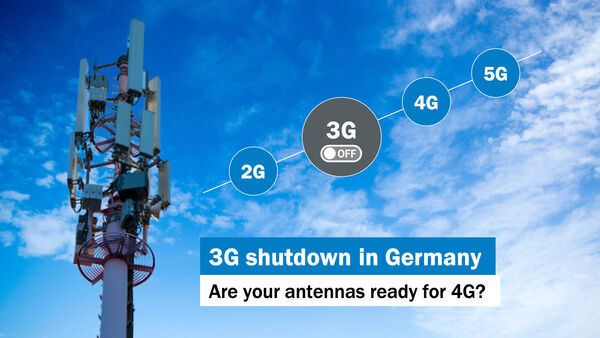The countdown is on
This year, the major mobile operators in Germany are shutting down the 3G network (also known as the UMTS network) after 15 years. The two largest network operators, Deutsche Telekom and Vodafone, are ringing in the farewell to 3G on June 30, 2021, while Telefónica/O2 has announced it will shut down its 3G network on Dec. 31, 2021. The reason: the freed-up 3G frequencies are needed for the expansion of the significantly faster 4G and 5G networks. While 3G technology is at a data transmission rate of 42.2 megabits, the LTE standard reaches 500 megabits per second and 5G up to 10 gigabits per second. The older and slower 2G network, on the other hand, will continue to be used for calls, text messages and the automatic emergency call system in vehicles (eCall).
No connection under this number
The shutdown of the UMTS network has consequences for mobile and stationary antennas. For example, anyone who wants to receive mobile communications via 4G in their car in the future must check whether the antenna installed in the vehicle is suitable for this. "We recommend a 4G check. In vehicles that are more than eleven years old, the probability is particularly high that the antenna cannot receive LTE," explains Wilfried Vedder from Antennentechnik Bad Blankenburg (ATTB), who looks after the topic of vehicle antennas and accessories. "This is because LTE was introduced in Germany in 2010. After the 3G switch-off, it is therefore for such vehicles: no connection under this number." The same applies to stationary antennas used to network devices such as electricity meters, elevators or industrial machinery. "The antenna must be 4G-capable, otherwise there is a risk of shutdown," adds Tobias Schneider, who specializes in so-called machine-to-machine communication at ATTB.
Wide range of LTE antennas
ATTB has a wide range of mobile and stationary antennas available for LTE retrofitting. "Our product portfolio includes around 80 LTE antennas. Among them are roof antennas, magnet mount antennas, adhesive antennas, control cabinet antennas and station antennas," says Wilfried Vedder. "We thus offer suitable solutions for a wide variety of installation situations in the mobile and stationary sectors." ATTB has been developing, testing and manufacturing the products in Germany for decades and is known in the market for particularly powerful and reliable antennas. The range is complemented by accessories such as adapters and extension cables. More information on the broad product portfolio is available in the ATTB product finder (https://bit.ly/3z1qGGc). The products are distributed via authorized partners in the DACH region and in Europe (https://bit.ly/3vQ0kFf).


Follow us